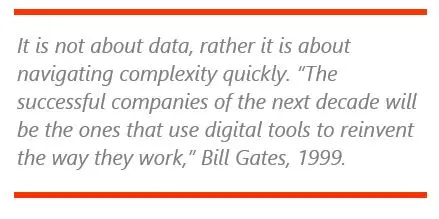

Keywords: Causal AI, Automation, Data, Digital Transformation, Business Optimization, Generative AI, ChatGPT, Industrial AI, ARC Advisory Group.
Industry has witnessed plenty of powerful disruptions to business in the last five years. The pace of change has increased and has taken on new dimensions with war, disease, economic upheaval, demographic shifts, public  opinion, and government regulations. On any given day, it seems the next crisis is just moments away. During this churn, it is easy for companies to lose focus on what is important.
opinion, and government regulations. On any given day, it seems the next crisis is just moments away. During this churn, it is easy for companies to lose focus on what is important.
Ultimately, companies exist to meet the needs of their customers. It is easy to get lost in the onslaught of promising new technologies and “solutions” offered to create “efficiencies” and agility. Although beneficial, many of these offerings are incremental solutions with limited scope and impact. Bigger, more transformative opportunities are missed as a result, leaving a more enterprising competitor an opportunity to step up and step in.
A handful of companies are beginning to see this bigger opportunity, but the ecosystem is too small. Because innovation happens faster in larger communities, this ecosystem must grow so industry can truly realize the potential business transformation and reinvent the way it does business.
At any given conference, attendees will hear the same challenges. Many of these challenges have been discussed for decades. Every year, one hears about competitive pressures. New challenges from developing markets or even old rivals. A more recent challenge to competitiveness is the supply chain upheaval recently experienced. For some industries, onshoring or reshoring are not a viable option, and when they are, they certainly cannot be addressed in a few months. Supply chain challenges require agile responses.
Labor-related challenges are another popular topic. How often is it stated that labor productivity is no longer increasing? New workers stay at any given job for less than three years on average. The time required to get new employees productive can take up to two years. Doing a little math, some estimation, and adding a bit of optimism would indicate that the future workforce is only fully trained 33 percent at best, at any given time. Although knowledge capture is being addressed by some, there are still large holes that must be addressed to mitigate the loss of competitive enterprise knowledge. The labor issue has been discussed at conferences for well over a decade and will be for the near future.
The challenge for industry is that markets have changed. It is not about data, rather it is about navigating complexity quickly. “The successful companies of the next decade will be the ones that use digital tools [AI?] to reinvent the way they work,” Bill Gates, 1999. This holds true even today.
Companies have data flowing from their proverbial ears. Historians, lab systems, procurement systems, maintenance systems, customer resource management systems, engineering repositories, compliance documentation, written procedures, incident reports, etc. Companies are struggling to make sense of each data silo and then understand all the data silos with context. They are investing in data lakes, data warehouses, data lake houses, yet continue to struggle with deriving timely, valuable insights and information beyond small microcosms within the organization. These microcosms noticeably match the sphere of influence of the internal champions. It appears companies are throwing technology at a wall and seeing what sticks, so to speak.
ARC Advisory Group clients can view the complete report at the ARC Client Portal.
Please Contact Us if you would like to speak with the author.
Obtain more ARC In-depth Research at Market Analysis

